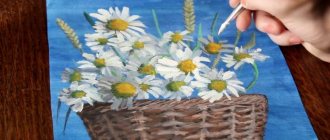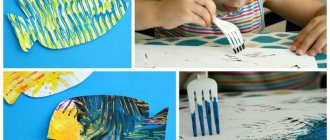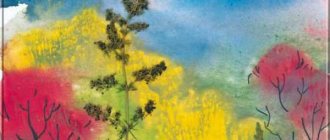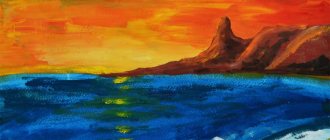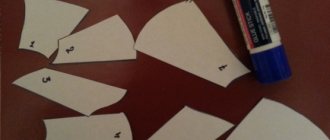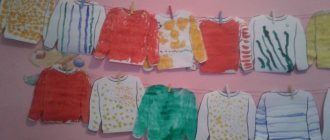On the topic: methodological developments, presentations and notes
Plan of drawing notes (preparatory group) on the topic: “Winter Landscape” using the non-traditional “Imprint” technique (drawing with vegetables).
Program content: Learn to draw rowan, highlighting the characteristic features of the bunch. Reinforce the idea of the color red; cultivate interest in collective creativity. Continue learning doat.
MBDOU "CRR - kindergarten "Bell" Summary of direct educational activities in drawing in the 1st junior group "Winnie the Pooh" Topic: "Wheels for the train" (non-trad.
summary of a drawing lesson in the junior group “Beasts in the Forest.”
Drawing outline for Cosmonaut Day using non-traditional drawing techniques.
Source
Weekly calendar plan on the topic “Shoes” for preschool educational institutions
Topic of the week: “Shoes”
Monday.
Morning.
1. Conversation “How I spent the weekend” - reinforce the concepts of “yesterday”, “tomorrow”, “today”, develop coherent speech, create an atmosphere of trust, cultivate polite communication.
2. D/I “It happens - it doesn’t happen” - develop attention, the ability to justify your answer, develop coherent speech, cultivate discipline
3. Interview “What are shoes for?” - teach children to ask and answer questions
4. Individual work: consolidate ordinal counting up to 5
5. D/I “Flag of Russia” - to help consolidate knowledge of the flag of your country, to consolidate the main colors of the flags, what do they mean?
6. P/i “Slippers” - develop coordination of movements with speech, motor skills, and cultivate responsiveness.
7. Practical exercise “Every thing has its place.” — teach to take care of things, remind that all things should be in their places.
GCD 1. Speech therapy
2. H.E.R. Modeling "
Slippers for grandma
."
Software tasks:
expand knowledge about house shoes; replenish children's vocabulary; teach children how to make house shoes - slippers without backdrops made of two parts (sole and upper part); consolidate the ability to use an unconventional image technique in work - plasticineography; consolidate the ability to use previously learned techniques for connecting parts, smoothing the place of fastening.
Material:
sole templates, plasticine, stacks, napkins, illustrations of slippers.
Vocabulary work:
pompom, ladies of the court, trimmed with fur.
Methodical techniques:
org. moment - a riddle, the history of the appearance of slippers, d / and “Form a word”, physical exercise, showing the stages of work, independent and ind. work, result.
3. H.E.R. Musical
Walk
1. Individual work:
jogging
2. Experiments “Winter Sun”. Objectives: Invite children to use simple experiments to find out whether the sun warms well. Bring the children to the conclusion that the sun weakly warms the earth, tell them that it does not rise high, its path across the sky becomes shorter.
3. Labor to organize snow removal. Objectives: to cultivate hard work and responsibility for the assigned work.
4. Physical exercises: Exercise your ability to jump on one leg.
5. Outdoor games: “Burners”, “Hunter and Hares”. Ts: Develop accuracy, speed, attention.
2nd floor day
1. Children's reading circle: C. Perrault “Puss in Boots.” Develop interest in fiction, improve listening skills, and develop emotional responsiveness. To develop an interest in the design of books.
2. C – p game “In the Obuv” store - to contribute to the formation of the ability to unite in the game, distribute roles, choose a convenient place, coordinate your actions with the actions of your partners, observe game relationships and interactions in the game, develop emotions that arise during game actions , contribute to the understanding of the received impressions, knowledge, and experience.
3. D/i “On the contrary”
. C: Develop the ability to compare objects by size (length, width, coordinate adjectives with nouns in gender, number, and select antonyms.
Walk.
1. Outdoor games “We are funny guys.” Goals: continue
teach to follow the rules of the game; intensify physical activity.
2. “Run to the tree.” Target:
strengthen dexterity.
3. Individual work “Drawing with a stick” (geometric figures, letters).
4. Fun games: “Let's go downhill” Develop general endurance, the ability to interact with peers, give in, help a friend.
Tuesday
Morning.
1. Game with the ball “Yesterday, today, tomorrow” - to consolidate the concepts of “yesterday”, “tomorrow”, to cultivate polite communication with peers and adults.
2. D/i “Dress the doll” - consolidate the names of clothes, shoes, develop the ability to select clothes for the season, cultivate aesthetic feelings, and interest in maintaining one’s health.
3. Individual work on the development of graphomotor skills
4. Games with Dienesh blocks - consolidate the names of geometric shapes, develop the ability to identify and abstract the properties of shapes, and cultivate determination.
5. D/I “Tell me about your family” - form an idea of yourself as a family member. Show the importance of family in a person’s life. Develop a desire to talk about your family members, be proud of them, love them.
GCD 1. Speech therapy
2. P.R. FEMP "
Composition of the number 9
»
Program tasks:
Learn to form the number 9 from two smaller numbers and decompose it into two smaller numbers. Introduce the mathematical signs “+” and “-”, be able to “read” them,
Practice measuring the height of objects using a conventional measure. Continue to develop the ability to navigate on a sheet of squared paper.
Vocabulary work:
plus, minus
Material:
counting sticks, numbers, notebooks, pencils, mathematical signs, a conventional measure - a herringbone, a set of Christmas trees of different heights, a ball.
Methodical techniques:
org. moment - “What does it look like”, composing the number 9, getting to know the signs, “reading examples”, solving examples, measuring using a conventional measure, physical exercises, working in notebooks, summary.
3. F.R. Physical education No. 23
II
half.
day H.E.R. Drawing " Boots
"
Program tasks:
teach children to independently draw with paints from life, as well as based on a sample; to form a sense of color, aesthetic taste, to expand the horizons of children, to develop the ability to form from beings. adjective, develop gross motor skills of the hands,
cultivate perseverance.
Vocabulary work:
sole, shaft, fastener, fringe.
Material:
paints, brushes, napkins, palette, children's boot, album sheet in the shape of a boot.
Methodical techniques
: org.
moment - a song about shoes, d/i “What kind of shoes are there?”, “Help the heroes of a fairy tale”, physical exercise, looking at a boot, drawing from life, ind. help from the teacher, result. Walk
1. Observation of the bullfinch Purpose: to expand ideas about migratory birds; develop the ability to analyze, compare, and draw conclusions.
2. P/i “Sly Fox” - improve children’s ability to run and maneuver, develop spatial orientation skills, develop speed and dexterity by introducing a second fox into the game, cultivate compliance with the rules of the game and the ability to adequately respond to losses.
3. Labor activity: - to cultivate hard work, responsiveness, mutual assistance,
4. Self-service: game situation “Tidy locker”. - teach children to maintain order in their locker, form the habit of taking care of personal belongings, cultivate neatness and independence.
2nd floor day
1. Individual work on orientation in space
2. D/i “Yes-no” (TRIZ) - to develop the ability to classify objects, teach to find the intended object, cutting off unnecessary signs.
develop the ability to listen to each other to the end.
3. D/i “My parents’ names are...”. To consolidate knowledge of the first and patronymic names of parents, grandparents...
4. Children's reading circle: E. Permyak “How Masha Got Big” - introduce the work, develop the ability to express one’s attitude to what they read, to the actions of the characters, continue to get acquainted with the genre features of the works, and cultivate respect for peers.
5. Ex. “Stitches” - introduce the “forward needle” stitch, develop the ability to act according to a pattern, develop fine motor skills, attention, cultivate dedication and hard work.
Walk.
1. P/i “Fishing Rod” - develop dexterity and speed of reaction
2. D/i “Go I don’t know where, find something I don’t know what.” Goal: to arouse interest and desire to play a mathematical game.
Wednesday
Morning.
1. Conversation “What does it mean to be a friend” - introduce children to models of friendly behavior, teach them to evaluate the actions of cartoon characters, form an idea of friendship, real friends, and cultivate compliance with the rules of personal safety.
2. Ex. “Let's decorate clothes with Udmurt ornaments” - develop creative thinking, artistic skills, fine motor skills, and cultivate aesthetic taste.
3. D/i “Guess the mood” - cultivate an attentive attitude towards others, learn to guess their mood, activate the vocabulary, develop observation skills.
4. Individual work to enrich vocabulary
5. Game of low mobility “Recognize by voice” - to form the ability to concentrate attention, develop auditory perception, learn to choose a driver and perform his functions in the game, cultivate compliance with the rules of the game.
GCD 1. Speech therapy
2. S.K.R. LIFE SAFETY FUNDAMENTALS "
If the child is lost
."
Software tasks:
clarify children's knowledge about the big city. To form knowledge about “strangers” and “our own”. Explain to children what dangers may await them when in contact with strangers. Check your home address and phone number. Explain safe behavior when interacting with strangers. Find out who you can turn to for help.
Vocabulary work:
avoid, later, terrorist
Material:
workbooks, pencils, d/i “Mail”, “Police”
Methodical techniques:
org. moment “Good-bad”, situational conversation “What would you do in this situation”, d/i “Postman” goal: to consolidate the knowledge and ability to name your full name, your address, s/r. game "Police". goal: to teach children to behave correctly on the street when they are alone; form the idea that you should not talk or leave with strangers.
3. H.E.R. Musical
Walk
1. Individual work Ex. "Throw and catch the ball"
2. Monitoring changes in snow depth. Tasks: Invite children to determine by eye the height of the snow cover in different places on the site, to determine where the “snow blanket” is thicker. Ask them to come up with a way to test their assumptions. Teach children to measure the height of snow cover using a ruler and compare using sticks.
3. D/i “It happens - it doesn’t happen” (with a ball)
. Develop coherent conversational speech.
4. Outdoor game “Higher than your feet off the ground.” - teach children to quickly respond to a signal, running to the opposite side of the playground, and teach them to comply with the rules of the game.
2nd floor day
1. Game “We tap the ball with our palm, repeat the sound together” - to develop gross motor skills
2. S – p game “Family”: plot “Family Holiday” - teach children to unite in the game, distribute roles, choose a convenient place, develop the ability to coordinate their actions with the actions of partners, observe game interactions in the game, cultivate responsiveness, mutual assistance. teach children to distinguish between categories of people such as relatives, relatives, friends, acquaintances. Contribute to the formation of competencies related to the fulfillment of social roles.
3. Introducing a mnemonic diagram for writing stories - descriptions about shoes
Walk.
1. D\i “How we dress.” Strengthen children's knowledge about shoes.
2. S/r and “Shop”: the plot “Choice of winter winter shoes”
3. Life Safety and Health “Winter Roads”. Goal: to expand children’s knowledge about the rules of behavior on the street and the road in winter.
Thursday
Morning.
1. D/i “Listen and count.” -development of auditory attention, elementary mathematical concepts.
2. Individual work on writing riddles-descriptions
3. Ball game “When does this happen?” -develop coherent conversational speech, the ability to accurately pass the ball to each other, consolidate knowledge about the seasons
4. Canteen duty – develop the ability to interact in the process of joint work: distribute responsibilities, negotiate among themselves
5. Game exercise “Hello, my name is...” - enrich children’s communicative and social experience, teach them to act politely and safely in various situations, understand what information can be shared about themselves and what cannot.
GCD 1. Speech therapy
2. P.R. FEMP "
Composition of the number 10
»
Program tasks:
Learn to form the number 10 from two smaller numbers and decompose it into two smaller numbers. Strengthen the ability to identify the previous, subsequent and missing number to the one named or indicated by a number within 10. Improve the ability to model objects using familiar geometric shapes. Continue to develop your orientation skills on a sheet of squared paper.
Vocabulary work:
subsequent, previous, skipped
Material:
numbers, counting sticks, Dienesh Blocks, notebooks, pencils.
Methodical techniques:
org. moment “Seasons”, composing the number 10, determining the previous and subsequent numbers, d/i “Find the missing number”, physical exercises, composing shoes from geometric shapes, working in notebooks, summary.
3. H.E.R. Drawing "
Boots for winter
»
Program tasks:
contribute to the formation of the ability to use an unconventional method of decoration (drawing with threads) to create a bright image. To introduce children to non-traditional drawing techniques, to form an idea of composing a pattern through the use of colored threads. Develop intellectual initiative, the ability to predict future changes, imagination and creativity; the ability to interact with adults and peers in the process of creative activity.
To cultivate artistic taste and aesthetic perception of the world around us.
Vocabulary work:
Material:
gouache, palette, threads, paper doll “Winter” without shoes. Presentation “Winter Time”, subject pictures depicting different items of footwear, stencils of boots - winter, autumn, men's and women's.
Methodical techniques:
verbal game “Say a word”, d/i “Give a compliment”, finger gymnastics, explanation and demonstration of a new way of acting; exhibition and discussion of children's works, result.
Physical education in games on a walk No. 12
Walk
1. Excursion to a shoe workshop - expand children’s understanding of the shoemaker’s profession, their place of work, the necessary tools, develop dialogical speech, cultivate observance of rules in public places, polite communication.
2. Individual work: jumps
3. Labor Clearing snow from the path leading to the feeder. Tasks: teach correctly, use a shovel, finish what you start.
4. Physical exercises: “Run to the flag.” Tasks: teach to monitor compliance with the rules, perform the duties of a judge, coach. Develop dexterity and attention.
5. P/n: “Owl”. Develop attention
2nd floor day
1. Children's reading circle: composing and solving riddles-descriptions about shoes - to develop the ability to write stories - descriptions about shoes, to activate vocabulary, to arouse interest in small folklore, to improve the ability to listen to each other to the end.
2. Game exercise “Helpers”. Teach children to come up with riddles - pantomimes, depict actions given by the driver, comment on which of them can be performed by children (wiping dust, watering flowers), which cannot (use a vacuum cleaner, iron, turn on the gas)
3. Game with the ball “One - many” - to develop the ability to coordinate nouns in the singular and plural, the use of plural nouns in the genitive case.
Walk.
1. Observation of a blizzard. Purpose: - to give an idea of the movement of snow in windy weather
2. Didactic games “Tell me which one?” Train the ability to form relative adjectives.
3. Experiments “Transferring a sun bunny”. Purpose: to show with an example how light and the image of an object can be reflected repeatedly.
4. Labor Clearing the labyrinth from snow. Objectives: to cultivate a desire to collectively improve your site.
5. Physical exercises: Performing exercises to maintain balance. Goal: to develop endurance.
6. P/n: “The fox in the hen house.” Objectives: To teach children to gently jump from a height to a designated place, to maintain balance when landing. Develop creativity in motor activity, cultivate self-confidence.
Friday
Morning.
1. Morning greeting “Compliment” - continue to cultivate children’s friendly attitude towards each other, develop an atmosphere of warmth, love and affection, enrich their vocabulary
2. Didactic game “Wonderful bag”. - teach children to identify by touch and name objects what they are made of.
3. Ex. “Lacing” - develop fine motor skills, visual perception, cultivate patience and diligence.
4. Individual work with scissors
5. The game “Cobweb” - create conditions for the development of children’s ability to negotiate and interact in a peer group.
GCD 1. Speech therapy
2. H.E.R. Application "
Shoes for the centipede
»
Program tasks:
develop the ability to convey the characteristics of objects through construction from paper and cardboard, to form children’s understanding of the technology of making shoes - summer slippers; cultivate a desire to help the weak.
Materials and equipment:
interactive game “Shoe Classification”, sample “Paper Slippers”, scissors, glue, napkins, outline of the sole made of cardboard, colored paper, strips of paper 15*4, 30*2 – straps for slippers, decorative decorations made of colored paper, bows , rhinestones, fur, etc., memo “Construction sequence”.
Vocabulary work:
sandals, decor
Methodical techniques:
org. “Centipede” moment, walking along health paths, d/i “Shoe classification”, “What kind of shoes”, looking at a sample, TB reminder, p/g, independent and ind. work, exhibition of works, poem by O. Ashpo “Who walks along the path”
3. P.R. Ecology «
Eco-friendly shoes
»
Program objectives:
Expand children’s knowledge about the variety of shoes, give children an idea of the concepts of “environmentally friendly shoes” and their purpose; consolidate with children previously acquired self-care skills and the skill of writing a descriptive story. Develop mental activity, creative imagination and fantasy, fine motor skills of fingers and hands. To instill a love of nature, a desire to take care of the cleanliness of the air and soil by creating environmentally friendly shoes, to cultivate a respectful attitude towards the work of scientists, and the desire to create something similar.
Vocabulary work:
environmentally friendly, natural, biodegradable.
Material:
pictures of shoes, examples of eco shoes, colored pencils, silhouettes of shoes
Methodical techniques:
org. moment - greeting, re-enactment of “Boots Quarreled”, d/i “Children’s Shoe Store”, conversation with children about shoes, teacher’s story, looking at pictures of shoes, physical exercise, creative game “We are eco-designers”, summing up.
II
half.
day F.R. Physical education No. 24 Walk
1. D/i “Does this happen or not?” Objectives: to develop logical thinking in children, to develop the ability to compare and contrast, and to identify inconsistencies.
2. Research activities. Rays of light always travel in a straight line, and if any object gets in their way, it casts a dark shadow. Conduct observation - morning, noon, evening. Take measurements. Conclude that at noon the sun is directly overhead, so the shadow is very short; Early in the morning and in the evening the sun drops in the sky, the shadows become long.
3. Labor to clear the floor of the veranda from snow. Objectives: teach how to perform labor actions.
4. Physical exercises: “Don’t knock down the flag.” Goals: continue to “snake” between objects without knocking them over; develop attention and observation.
5. Individual work. Jumping on two legs
2nd floor day
1. Experiments with paints, color “Wonderful transformations of blots” - to form an idea of the arrangement of colors in the rainbow, develop color perception and color discrimination, the ability to distinguish colors by saturation, name shades of colors (blue, bright blue, light blue, dark blue and etc.), arouse interest in research activities, develop imagination, cultivate independence, accuracy
2. S – p game “Family”: the plot of “Cafe” - to cultivate goodwill, politeness, friendly relationships in the game, continue to teach children how to build dialogue in the game.
3. Children's reading circle. M. Smirnova “Tanya is an incompetent” - improve the ability to understand questions about the work and answer them. Develop an interest in fiction
4. Household work - cultivate diligence, neatness, teach children to restore order in the group
Walk.
1. D/i: “Let’s dress the doll for a walk.” Develop the ability to find shades darker or lighter.
2. S/r game “Livestock Breeders”. Objectives: to develop children’s social skills, the ability to negotiate, agree on a game, distribute roles, look for ways out of conflict situations
3. Life safety “Winter roads” Purpose: to expand children’s knowledge about the rules of behavior on the street and roads in winter.
Summary of educational activities on subject drawing for children 5–6 years old with mental retardation “Rubber boots”
Tatiana Kulagina
Summary of educational activities on subject drawing for children 5–6 years old with mental retardation “Rubber boots”
-Systematize children’s knowledge about seasonal clothing and shoes.
— To develop children’s in visual arts,
— Develop aesthetic perception of household items ,
— Cultivate goodwill when assessing the work of comrades, develop emotional responsiveness;
-Develop a caring attitude towards shoes.
-activation of the dictionary on the lexical topic “Clothing. Hats. Footwear: Autumn, it’s raining, rubber boots , leather boots , shoes, house slippers;
-enrichment of vocabulary: introduce children to the concept of “pair of shoes”
2. Preliminary work:
Examination of illustrations: Autumn, Clothes, Shoes, Hats;
Observing the weather in the kindergarten area, observing changes in the clothing of children and adults .
Didactic games: “Collect a picture”
,
“Dress the doll for a walk”
;
“Make clothes from parts”
; Different types of lacing.
Printed board game “Loto. Cloth. Shoes. Hats"
;
V. Stepanov “The ABC of the Seasons”
Poems and stories about autumn
S. Mikhalkov “Masha the Confused”
E. Blaginina “How smartly you are dressed.” Watching cartoons and educational films about shoes.
3.Materials and equipment:
- sippy cups with water,
- brushes of two sizes,
4. Scenario of an educational situation.
1. Introduction to the game situation (elements of psycho-gymnastics)
:
-Children, what time of year is it now?
Walk in boots . We will go for a walk in rainy weather in rubber boots We take off our boots , put them in a box and go to the tables.
Preview:
Summary of a drawing lesson in the senior group
“Decorate your boot with a Bashkir pattern”
- To develop in children the ability, using familiar and new elements of the Bashkir ornament, to decorate the Bashkir boot - itek; consolidate knowledge of the compositional construction of a pattern, apply the coloring characteristic of this product.
- improve children’s ability to saturate the brush well with paint, hold it obliquely when drawing wide lines and vertically when drawing narrow lines; develop artistic taste.
- cultivate love for the native land and accuracy in work.
Activation of the dictionary: itek, bird's head.
Devices and materials:
Silhouettes of Bashkir boots for each child; gouache paints; brushes for decorative painting; plastic jars with water; cups for brushes; napkins; linings; magnetic easel; algorithms for drawing a new element “bird head”; picture with different shoes; Dunno doll; tape recorder with a recording of a Bashkir melody.
- viewing illustrations depicting people in Bashkir national costumes; acquaintance with dolls in Bashkir costumes.
- conversations about the Bashkir ornament: its construction, elements, color.
- d/games: “Decorate the boot” (ready-made elements of the Bashkir ornament), “Weave a carpet” (drawing a Bashkir pattern from geometric shapes), “Trace and color” (templates of elements of the Bashkir ornament), “Dress Aigul and Salavat.”
- decorative drawing in previous lessons: “Decorate the tablecloth”, “Beautiful towel”.
- modeling “Bowl for Aigul”,
- visit to the Center of National Cultures.
Educator: Good afternoon, October people. Why did I call you that?
Children: we live in the city of Oktyabrsky.
Educator: What republic do we live in?
Children: we live in Bashkortostan.
Educator: Our republic is peaceful and hospitable. People of different nationalities live in it in friendship and harmony.
The group includes Fairuza Frvazovna (in Bashkir national costume)
Fairuza Frvazovna: Hello, guys (says hello in Bashkir). I came to you for help. Please help me decorate Bashkir boots for kids to play with.
He takes out the silhouettes of a Bashkir boot from a large envelope.
Fairuzu F.: Look what I brought you. This boot is called - itek - Repeat, guys, what it’s called.
Fairuzu F.: Pay attention to the appearance of the boot. It is straight, without a heel, on the top there is a black stripe that needs to be decorated with a Bashkir pattern.
Educator: Don’t worry, Fairuza Farvazovna, our guys will definitely help you and decorate your boot with a Bashkir pattern.
Fairuza F.: Thanks guys, I'll come see you later.
Dunno: I also have Bashkir boots, look how many there are.
Shows a picture with different shoes.
Children: No, Dunno, there are no Bashkir boots here, there are different shoes here.
Educator: How did you find out?
Children: The Bashkir boot is straight, without a heel, and has a black stripe on the top.
Educator: Correct. I propose to decorate a Bashkir boot with this pattern (showing a sample). Look at the pattern, what elements does it consist of?
Children: From circles and diamonds.
Educator: Please note that the diamonds are not simple, they have branches. This element is called a “bird’s head”.
Go find yourself a place to paint.
Children set up tables and take their places.
Educator: So what are we planning to do with you?
Children: Decorate the boot with a Bashkir pattern.
Educator: What do we need for work?
Children: Paints, brushes, water, pads, napkins. We will do everything in order, and we will get a beautiful Bashkir boot.
Educator: Go, prepare everything you need for work.
Children are preparing jobs.
Educator: Now come to me, I will teach you how to draw this Bashkir pattern. First, I will visually divide the black stripe into two parts with a horizontal line (I show with my hand). I will draw circles at the top and a diamond at the bottom. I’ll draw a cross at the bottom of the black stripe: I’ll draw a long stripe from top to bottom, and a short stripe in the middle. I connect the ends of the cross to form a rhombus, paint over it and draw the branches - the stick up and a little down.
Educator: Kamila, how do I paint, with the whole brush or the tip?
Camila: With the tip of a brush
Educator: Vasya, tell me, what colors can you use to paint the Bashkir pattern?
Vasya: Red, orange, yellow, burgundy, green.
Educator: Tell me, Vika, where will you start drawing this element of the pattern?
Vika: I’ll draw a cross, then connect the ends and make a diamond.
I will paint over the diamond and draw the branches.
Educator: Go and draw.
The teacher puts on the board algorithms for drawing a complex element and an example of a Bashkir pattern.
Independent activity of children (to a Bashkir melody)
While the children are working, the teacher pays attention to the children’s posture and reminds them of the drawing technique: paint with the tip of a brush, rinse the brush well, then add new paint, etc.
Educator: What pattern did you decorate the itek with?
How can you find out that this is a Bashkir ornament (list the elements of the Bashkir ornament, color).
Well done guys, what beautiful Bashkir boots you drew for kids.
Source
